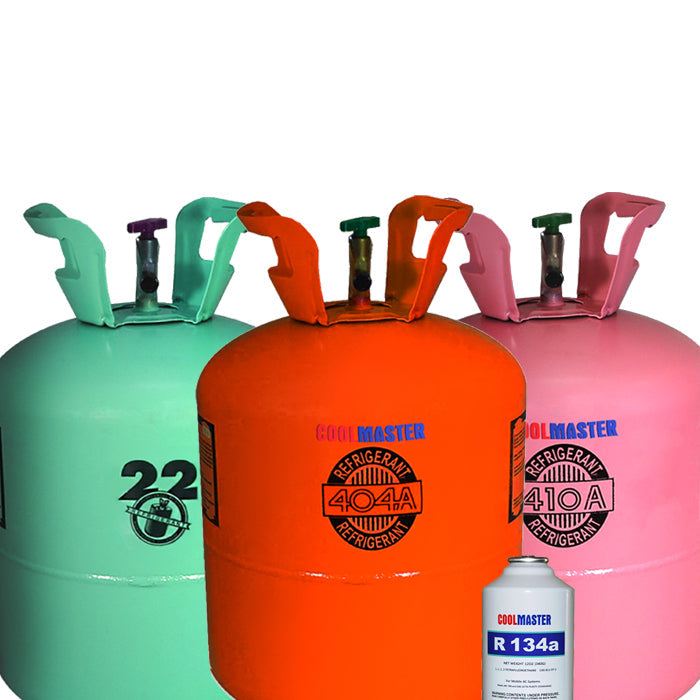321-245-1400
321-245-1400

Refrigerants play a vital role in HVAC systems, providing the cooling and heating functions we rely on for comfort and efficiency. As the heating and air conditioning industry evolves to be more environmentally conscious, selecting the right aircon unit is key to avoiding costly and environmentally damaging refrigerants. With stricter regulations and a shift toward energy efficiency, businesses and homeowners alike need to be aware of the best refrigerant options for their needs as this will dictate the unit they should purchase. This post will guide you through the types of refrigerants that are well-suited for homes and businesses, helping you make informed decisions for your A/C purchasing needs.
For homeowners, the goal is often to balance energy efficiency, cost, and environmental impact. Some of the most common refrigerants used in residential systems are R-22, R-410A, and R-32.
R-410A was the standard refrigerant for air-conditioning systems for many years and is still commonly used in residential applications. It is ozone-safe, having no Ozone Depletion Potential (ODP), and offers improved energy efficiency compared to older refrigerants. However, R-410A has a higher Global Warming Potential (GWP) than newer refrigerants, prompting its gradual phase-out in favor of more eco-friendly alternatives. Despite this, R-410A is still widely available as a recycled refrigerant. While it remains a suitable choice for short-term upgrades, homeowners should carefully examine the cost of operation if they plan to install an aircon that uses R-410A.
R-32 is another great option for homeowners who prioritize sustainability. This refrigerant is more energy-efficient than R-410A and has a much lower Global Warming Potential (GWP). R-32 is gaining popularity in residential air conditioners due to its improved efficiency and smaller environmental impact. If you're planning to install a new heat or cooling system that uses this refrigerant, it is a smart choice for future-proofing your home and reducing energy costs in the long run.
For businesses, the choice of climatization unit will be heavily influenced by system size, regulatory compliance, and operational costs. In commercial settings, companies should consider refrigerants that offer scalability, long-term durability, and efficiency, particularly for large-scale HVAC or refrigeration systems.
Just like for homes, R-410A remains a widespread in light commercial climate control systems. Many small and medium-sized businesses use R-410A because they choose heating and air conditioning units that provide a solid balance of energy efficiency and environmental responsibility. However, businesses with larger systems or high refrigeration demands may require something more specialized, as R-410A may not be the most cost-effective option for commercial applications. As the phaseout of R-410A continues, this refrigerant will be increasingly costly to maintain for larger systems.
For businesses that require refrigeration systems, particularly in industries like food service or retail, cooling units that utilize R-134a are widely used, providing a stable and efficient system. It is a great refrigerant for medium-temperature refrigeration, such as commercial freezers and display cases. However, while R-134a is a step up from R-22 in terms of environmental safety, it still has a high GWP. As such, some businesses might look to transition to alternative mechanical cooling units in the future.
Systems that use hydrofluoroolefins (HFOs), such as R-1234yf and R-1234ze, are emerging as top-tier systems for both residential and commercial applications. Their ultra-low GWP makes them excellent choices for businesses that want to stay ahead of stricter environmental regulations. These refrigerants are already seeing widespread adoption in the automotive industry and are gradually making their way into commercial refrigeration and air conditioning. While HFOs are more expensive upfront, their environmental benefits and compliance with future regulations make them an attractive long-term investment for businesses looking to reduce their carbon footprint through future-proofing their climate control units.
For both homes and businesses, R-22 is a refrigerant to avoid if you’re upgrading or replacing your A/C system. While it was once the standard refrigerant, R-22 is being phased out due to its high ozone depletion potential. Its production and importation are restricted, making it increasingly difficult to find. Additionally, the cost of servicing systems that still use this antiquated refrigerant is high, as older systems are not as energy-efficient and require more frequent repairs.
R-12 is another outdated refrigerant that has been completely phased out for both residential and commercial systems. It was once used in older cars and heat/cooling systems but has since been banned due to its environmental harm. If you still have systems that use R-12, it is essential to replace them as soon as possible to comply with environmental regulations.
Selecting the best refrigerant for your home or business involves finding an HVAC unit that balances environmental impact, energy efficiency, and system compatibility. Modern refrigerants like R-410A and R-32 offer substantial improvements in performance and sustainability for residential applications, while R-134a and HFOs are great choices for commercial settings.
By understanding which refrigerant suits your needs, you can purchase a heating and air conditioning unit that reduces operational costs, improves energy efficiency, and ensures compliance with ever-changing regulations. Whether you're upgrading an old system or installing a new one, consulting with an HVAC professional can help you make the most informed decision for your home or business.